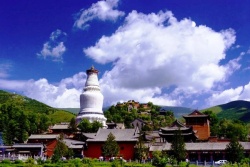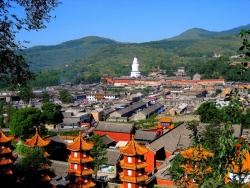Wutai Mountain China
Wutai Mountain has the longest and most prestigious history of the four well-known Buddhist Mountains.
Located in Wutai Country of Shanxi Province, 240 kilometers from the provincial capital of Taiyuan, the mountain is actually a cluster of five terrace-like peaks — East Terrace, West Terrace, South Terrace, North Terrace and Central Terrance, hence the name Wutai, Five Terraces.
The North Terrace is the highest peak — about 3,058 meters above sea level — and is named as the Roof of North China. Wutai Mountain covers 2,873 square meters, spanning more than 100 kilometers.
Wutai Mountain is a famous scenic spot under national protection. It is famous for its Tibet-like bright blue sky and the breath taking natural beauty — beautiful surroundings, with trees covering ancient temples and monasteries. The buildings look exceptionally impressive, and the stone carvings are of superb craftsmanship. The painted sculptures are of various shapes and types and no two sculptures are of the same kind.
In the mountain area, spring arrives in April, and snow falls in September and even in mid-summer, it is cool and pleasant. The cool and pleasant summer climate of Wutai Mountain has also given rise to another name: Qingliang (Cool and Pleasant) Mountain. The mountain has been regarded as an ideal place for escaping summer heat since ancient times.
Today, most of the temples are still in good condition. Within their walls is a rich legacy of over 100,000 superb sculptures and paintings, along with a great quantity of Buddhist cultural relics.
For hundreds of years, Wutai Mountain has been China’s most sacred Buddhist ground because it was where the highly revered Manjusri, the Bodhisattva of Wisdom, once lived and taught. Numerous temples on Wutai Mountain contain many relics and have different features.
With a history of 1,200 years, the main hall of the Nanchan Temple on the mountain, which houses 17 painted figurines, is the earliest wooden structure of its kind preserved in China today. And it’s a real treasure of China. Its eaves stretch out, and the hall has not a single column. Its outer appearance looks simple and its structure concise, which are similar in style to the Tang Dynasty art.
The Big White Pagoda for Buddha’s Sarira, the symbol of the Wutai Mountain, is said to have been built there before the Emperor Mingdi of the Eastern Han Dynasty. The pagoda, in Nepalese style, has a base circumference of 83.3 meters and is 75.3 meters high. Inside the pagoda, there is small India-made iron stupa, where some remains of Sakyamuni are kept.
Xiantong Temple is the oldest temple in China and also the biggest on Wutai Mountain. Originally built in the Eastern Han Dynasty, it has been placed under state protection. Covering eight hectares, the temple has 400-odd halls. Inside, there are 3 pure copper halls cast in the Ming Dynasty (1368-1644), engraved with fine patterns and bronze Buddhist figurines. On the sides, two 13-storied bronze towers also made in the Ming Dynasty (1368-1644), each with a height of eight meters, are covered with cast Buddhist figurines, carved patterns and various inscriptions.
For hundreds of years, Wutai Mountain has drawn emperors from various dynasties here on pilgrimage, adding more significance to the mountain. Furthermore, Wutai Mountain is China’s only holy mountain where both Chinese Buddhism and Tibetan Lamaism are practiced. Dalai Lamas, Panchen Lamas and many high tulkus have visited and preached here, some are even buried here.
During the Tang Dynasty (618-907), a Buddhist academy was established here, attracting believers from not only China, but India, Ceylon, Nepal, Tibet, Mongolia, Korea, and Japan.

